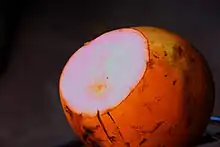King coconut
King coconut (Cocos nucifera var aurantiaca) is a variety of coconut, native to Sri Lanka, where it is known as Thæmbili (Sinhala තැඹිලි), also found in India and Indonesia.[1] It has less sugar content than other coconuts. There are several sub-varieties of the king coconut, the most common being the "red dwarf" (kaha thæmbili, commonly referred to as gon thæmbili). The other variety is "Ran Thæmbili",[2] a smaller variety containing about forty nuts in a bunch. The king coconut tree is shorter than coconut trees, and is commonly found growing wild in many areas of the country.[3]


The king coconut water, or liquid endosperm of young King coconut is a nutritious beverage rich in sugars (mainly reducing sugars), minerals (mainly K+), vitamins (mainly B & C) and amino acids.[4] King coconut water has been used in Ayurveda (herbal medicine). One of the most common uses is a mixture of Aralu powder (Myrobalans) added to the water of a king coconut.[5]
Sri Lanka now exports packaged king coconut water in a variety of brands.
There are many cultivated coconut varieties found in Sri Lanka. Most of them undergo research through the National Coconut Research Institute. According to research, the National Coconut Research Institute identified these varieties during a recent coconut germplasm exploration mission in the Southern Province of Sri Lanka.
Coconut in Sri Lanka is currently classified into 15 different forms grouped under three varieties, 'Typica', 'Nana' and 'Aurantiaca'. The visual morphological features of several new coconut morphotypes were characterized to include them in the taxonomic classification of coconuts in Sri Lanka.[6] It is also found in some parts of Kerala, where it is known as (Chomana Thenga) or red coconut.
Varieties and forms of coconut found in Sri Lanka
| Common name | Variety/form | Features |
|---|---|---|
| Sri Lanka Tall | (Typical/Typica) | Tall stature, allogamous, heterogeneous, flowers in 6–7 years, medium-sized nuts, 20–25 nuts per bunch, 60–80 nuts per palm per year. |
| Gon Thæmbili | (Typica/Gon Thæmbili ) | Similar to Sri Lanka Tall. Ivory-coloured nuts, petioles, and inflorescences. |
| Nawasi | (Typica/Nawasi) | Similar to Sri Lanka Tall. Soft mesocarp edible in the immature nut. Yields soft fibre when mature. |
| Pora pol | (Typica/Pora pol) | Similar to Sri Lanka Tall. Remarkably thick-shelled nuts. |
| Ran Thæmbili | (Typica/Ran thæmbili ) | Similar to Sri Lanka Tall. Pink-coloured mesocarp in immature fruit and a pink whorl under the perianth. Large nuts. |
| Kamandala | (Typica/Kamandala) | Similar to Sri Lanka Tall. Large-sized nuts (largest among local forms), and few nuts per bunch (2–5 nuts per bunch). |
| Bodiri | (Typica/Bodiri) | Similar to Sri Lanka Tall. Small-sized nuts, and large number per bunch (30–100 nuts per bunch). Seasonal nut production. |
| Dikiri | (Typica/Dikiri) | Similar to Sri Lanka Tall. Some nuts contain a jelly-like endosperm. |
| King Coconut | (Aurantiaca/King coconut) | Intermediate stature, autogamous, homogeneous, fruits in 6–7 years, seasonal flower production, medium-sized nuts with orange epicarp, and sweet nut water; 25–50 nuts per bunch. |
| Nawas Thæmbili | (Aurantiaca/Nawasi thæmbili ) | Similar to King Coconut. Soft and edible mesocarp like Nawasi. |
| Rathra Thæmbili | (Aurantiaca/Rathran thæmbili ) | Similar to King Coconut. Pink-coloured mesocarp, and a pink whorl under the perianth. |
| Green Dwarf | (Nana/Green dwarf or Pumila) | Dwarf stature, autogamous, homogeneous, fruits in 3–4 years, small-sized nuts with green epicarp. Low copra content, 80–150 nuts per palm per year. |
| Yellow Dwarf | (Nana/Yellow dwarf or Eburnea) | Similar to Green dwarf. Nuts with yellow epicarp. |
| Red Dwarf | (Nana/Red dwarf or Regia) | Similar to Green dwarf. Nuts with red epicarp. |
| Brown Dwarf | (Nana/Brown dwarf or Braune) | Similar to Green dwarf. Nuts with a brown epicarp. |
See also
References
- "WHAT IS KING COCONUT?". Archived from the original on 2016-09-17. Retrieved 2015-12-21.
- "Thambili - Punchi Lindey Vathura Rasai". Archived from the original on 2016-03-03.
- "Coconut varieties". florida gardener. Retrieved 19 May 2016.
- "CHAPTER 9: Country reports on status of coconut genetic resources research". Coconut Genetic Resources (PDF). International Plant Genetic Resources Institute – Regional Office for Asia, the Pacific and Oceania (IPGRI-APO), Serdang, Selangor DE, Malaysia.: Pons Batugal, V. Ramanatha Rao and Jeffrey Oliver. 2005. p. 587. ISBN 92-9043-629-8.
- "King Coconut" (PDF).
- Ekanayake, G.K. , Perera, S. A. C. N. , Dassanayake, P. N. , Everard, J. M. D. T. (2010). "Varietal Classification of New Coconut (Cocos nucifera L.) Forms Identified" (PDF). Coconut Research Institute of Sri Lanka. p. 10. Retrieved 19 May 2016.
{{cite web}}: CS1 maint: multiple names: authors list (link)